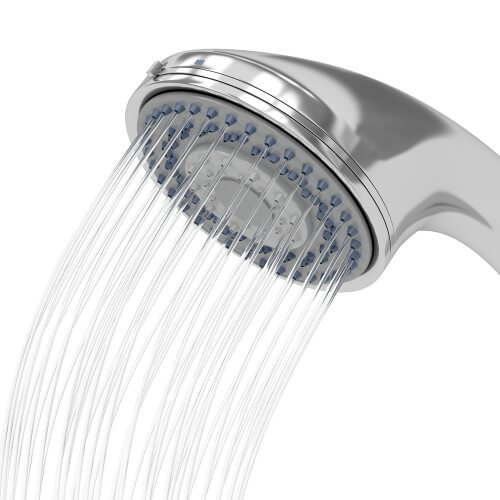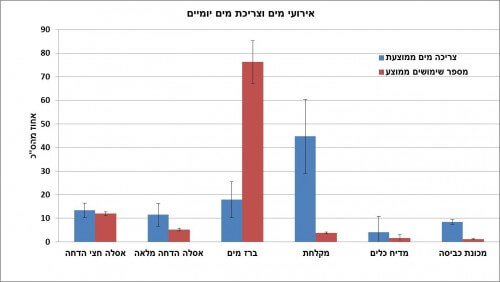The average Israeli turns on the faucet 19 times a day, and his daily water consumption is 123 liters. Technion researchers presented at the conference of the Grand Institute for Water Research a unique algorithm that segments private water consumption habits

Technion researchers from the Faculty of Civil and Environmental Engineering have developed an algorithm that maps household water consumption and offers a model for reducing it. The system was developed by the researchers as part of a comprehensive study taking place at the Technion in collaboration with the IFAK Institute (Institut für Automation und Kommunikation) from Magdeburg in Germany, and examines the effect of recycling and saving water in residential buildings on the municipal wastewater system.
As part of the research, which was recently presented at the Water Research Conference in Israel - the second conference for research students of the Grand Institute for Water Research at the Technion, a system was built that monitors and catalogs water usage automatically, and provides information on the distribution of water consumption in real time. In a study conducted under the guidance of Professor Eran Friedler from the Faculty of Civil and Environmental Engineering at the Technion, student Dennis Steinberg examined the distribution of domestic water consumption at the level of the individual device. Using the computerized algorithm for identifying and characterizing the water consumption of each "water consuming" device in the home that he developed, Steinberg mapped the water consumption patterns in the monitored residential apartments. Using data obtained from a single sensor (developed as part of the research) based on a water meter and a data logger installed in each of the apartments, the developed algorithm knows how to identify the type of consumption at any given moment - is it washing hands, a washing machine, flushing a toilet, etc.
And here are the conclusions: an average person opens the faucet about 19 times a day during the week, and his daily water consumption is 123 liters (101 liters without garden watering), and on weekends it increases by about 20 liters more. 3:00 at night is the 'dead time' for water consumption, 7:00 in the morning is the peak time, and between 18:00 pm and midnight there is a very high consumption. The shower, which takes up a total of 4% of the number of "water events" per day, is the biggest consumer of water; The taps occupy 76% of the total events but only 18% of the total consumption volume; And watering a garden (if any) increases the total consumption of each tenant by 17%.
And what about the washing machine, where the water rolls for a long time? Here is the answer: the washing machine consumes only 8% of the water volume in the middle of the week and 9.8% at the weekend.

"The research was based on 16 volunteer families, living in apartments and single-family houses," explains Steinberg, "with the help of the algorithm we developed, each consumer receives a map of their water consumption and thus they can optimize their use and save water. If funding is found, we will be happy to expand the study to a larger group." "This is a joint Israeli-German research, which takes place within the framework of a joint fund for the German and Israeli ministries of science." said Professor Eran Friedler. "Its main goals are to learn how and where water can be saved, and to understand the potential of water recycling and the use of gray water and its impact on the municipal wastewater system. The algorithm developed by Denis will allow us to better understand the distribution of domestic water needs and to recommend how to increase water saving and water reuse at the level of the individual house."

8 תגובות
Yigal
I know you're trying to push your agenda (and I'm not opposed to it in principle), but let's address the numbers. It says that an Israeli consumes 123 liters a day, and you say a cow consumes 200 liters a day. There are 7 million Israelis and 120 thousand Israeli cows (http://www.milk.org.il/cgi-webaxy/sal/sal.pl?lang=he&ID=645657_milk&act=show&dbid=katavot&dataid=israel_cow.htm). So - the consumption of water by cows is quite negligible in our "drying" country, isn't it?
Am I wrong?
Miracles, it is impossible to make a separation and any attempt to make such a separation is fundamentally wrong.
There is a need for humans. This. Why? Because it doesn't matter who wastes the water, it is wasted. by you
Whether you waste the water directly (shower, washing machine, dishwasher, etc.) or indirectly
(consumption of meat and dairy products) – you(!!) is the one who wastes this water.
20 thousand liters of fresh drinking water (in a "drying" country) for every kilo of meat is not normal.
This is the fast track to the collapse of the Earth.
Regarding your question, "How much water is needed to provide the same essential nutrients from other sources?"
I don't remember the numbers, but it "costs" us much, much less to irrigate an area intended for growing edible plants
approves the same area for raising animals.
Last time I checked, wheat does not consume 200 liters of water a day. A cow yes.
In conclusion, make a comparison between which uses more water - the shower or the washing machine
Without taking into account that every kilo of meat you consume is enough for two and a half months of showers - she is disconnected from reality
and denying him. And it is impossible to solve a problem that you are unwilling to admit exists or that you are looking for justifications and excuses for.
Yigal
I meant the biggest domestic consumer... agriculture consumes more of course
Yigal
Let's assume that your figure is correct (and from what I know it really is something like that). A hamburger is 100-200 grams of meat, which is a little less than a kilo... and of this amount of water, how much is available for other purposes? It's not all about watering.
And for the same kilo of beef - how much water is needed to provide the same essential nutrients from other sources?
Just so you know, the biggest consumer of water in the US is... grass.
Who needs more? You're kidding, right?
Why doesn't anyone talk about the real sinkhole and deal with such marginal things?
To produce a kilo of meat requires 20,000 liters of water. I repeat - 20,000 liters of water. When a person eats a hamburger and a steak, he wastes 20K liters of water. He can save in the bath, in the tap, in drinking, in the garden, put in savings, and everything that comes to his mind. But then what's the point if he continues to consume meat and milk???
How can you write a serious article without referring to the big elephant standing in the center of the room?
I don't like these mesh bags, an important part of washing machines is the friction element of the clothes against each other with the help of the bumps (ribs) on the drum, when you put all the socks in a fabric bag the friction effect is lost and the laundry is less clean.
Eyal, that's what there are mesh (fabric) bags for socks...
By the way, washing machines sometimes swallow socks, this is not a myth.